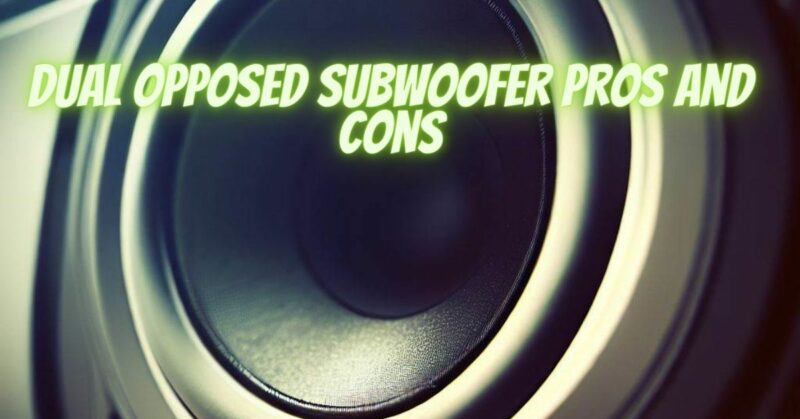Dual opposed subwoofers are a popular configuration used in home theater and audio systems. This setup involves two subwoofers positioned face-to-face or back-to-back, with their drivers and enclosures arranged in opposite directions. In this article, we will explore the pros and cons of dual opposed subwoofers, helping you understand the benefits and considerations of this configuration.
Pros of Dual Opposed Subwoofers:
- Reduced Cabinet Vibration: Dual opposed subwoofers exhibit less cabinet vibration compared to single subwoofers. The opposing forces generated by the drivers in opposite directions help cancel out vibrations, resulting in a more stable and rigid enclosure. This can lead to cleaner and more accurate bass reproduction, with reduced unwanted resonances and distortions.
- Improved Power Handling: The opposing driver arrangement allows for better power handling capabilities. Each subwoofer driver shares the workload, distributing the power demand and reducing the strain on individual drivers. This can result in improved overall performance, higher output levels, and reduced chances of driver fatigue or damage, particularly in demanding low-frequency passages.
- Balanced Acoustic Output: Dual opposed subwoofers can help create a more balanced acoustic output throughout the room. The opposing forces generated by the drivers can minimize room resonances and standing waves, leading to smoother bass response and reduced localized peaks or nulls. This can result in a more even and uniform bass distribution, enhancing the listening experience for multiple seating positions.
Cons of Dual Opposed Subwoofers:
- Larger Physical Footprint: Dual opposed subwoofers typically require more physical space compared to a single subwoofer. The face-to-face or back-to-back arrangement necessitates adequate room for both enclosures and drivers. If space is a constraint, this configuration may not be suitable or practical.
- Increased Cost: Having two subwoofers instead of one means an additional investment in terms of equipment cost. Dual opposed subwoofers generally require the purchase of two identical subwoofers, which can be more expensive compared to a single subwoofer. Additionally, the need for additional cables and connections may also add to the overall cost.
- Placement Constraints: Dual opposed subwoofers may have specific placement requirements for optimal performance. The opposing forces generated by the drivers need to be balanced, and the subwoofers should be positioned appropriately to achieve the desired cancellation effect. Finding the right placement and positioning can be more challenging compared to a single subwoofer setup.
Conclusion:
Dual opposed subwoofers offer several advantages, including reduced cabinet vibration, improved power handling, and balanced acoustic output. These benefits can contribute to cleaner and more accurate bass reproduction in home theater and audio systems. However, it is essential to consider the larger physical footprint, increased cost, and placement constraints associated with this configuration. Assess your specific needs, room size, and budget to determine if dual opposed subwoofers are the right choice for your audio setup. If space and budget permit, and you value the potential sonic benefits, dual opposed subwoofers can be a worthwhile investment for enhanced bass performance and overall listening enjoyment.


